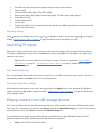
39
• Music – AAC, MP3, WMA, WAV (PCM), AIFF, FLAC, AC3, and DTS
+
• Photo – PG, PNG (up to 4k x 4k pixels), GIF (up to 4k x 4 k pixels)
To see the latest list of supported formats, view Help in the Media Player.
The Roku/USB Media Player displays supported le types * only, and hides le types it knows it cannot play.
Playing content from local network media servers
If you have connected your TV to a network, it can play personal video, music, and photo les from a media server
on your local network. Media servers include personal computers running media server soware such as Plex or
Windows Media Player, network le storage systems that have built-in media server soware, and other devices that
implement the specicaons of the Digital Living Network Alliance. Some servers do not fully implement the DLNA
specicaon but are UPNP (Universal Plug and Play) compable. The Roku Media Player will connect to them as well.
Some media servers can convert les into Roku compable formats. DRM-protected content is not supported.
Adjusng Haier • Roku TV sengs
You can adjust most picture and sound sengs while you are watching a program by pressing to display the
Opons menu. If you don’t nd what you need, there are addional picture and sound sengs in the Sengs menu.
In most cases, the seng changes you make apply only to the input you are using. Antenna TV, each separate HDMI®
input and the AV input have their own sengs that the TV remembers when you return to that input. The TV also
remembers the sengs that you specify while viewing streaming content.
Settings menu
Use the Sengs menu to adjust overall TV sengs. Press to go to the Home screen, and then navigate to Sengs
> TV picture sengs.
You can adjust the following overall TV picture sengs from the Sengs screen:
• TV brightness – If the lighng level in your TV room changes, use this seng to help provide a beer
viewing experience; set to darker for a darker room, and brighter for a brighter room. Choose among
Normal and four other sengs to make the overall picture brighter or darker. So that you don’t have
* There are many variants of each of these media formats. Some variants may not play at all or may have issues or
inconsistencies during playback.
DTS audio, whether in music or video les, is supported only by pass-through, meaning that the TV cannot directly
output the sound of a DTS le, but can pass it through to a DTS-compable receiver that is connected to the HDMI
ARC or S/PDIF connector on the TV.


















